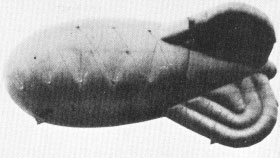 Click to return to Site Directory
Click to return to Site Directory
 Click to return to Site Directory
Click to return to Site Directory
History of Balloons in Warfare
The use of airborne devices to fight wars is much older than many people realise. Prior to balloons the humble kite was modified and redesigned
many times by various nationalities notably the Chinese. Ancient Chinese tales talk about large kites that could lift a man and give him an aerial
view of the battleground. Other kites were launched with strings that vibrated and the the intention was to make sounds that would frighten the
enemy. Kites were used by the Chinese for signaling and even to drop a primitive form of propaganda leaflet on the enemy.
The first time an aerial device was used in sea borne warfare with absolute certainty was that of the British 32 gun Frigate Pallas commanded by
Thomas Lord Cochrane in the Bay of Biscay in 1806.
This ship towed kites from the ship and flew them over the French Coast, they contained a series of printed documents addressed to the French
people and were clearly propaganda. They were released over French soil by use of a match to burn through the string and release the documents
into the sky.
Russian claims that a manned hot air balloon flight took place on 17th November 1731 exist. The claim is that a Mr Kriakoutny flew a balloon made
of ox hides from Ryazan town square and landed in the church bell tower. He was beaten by superstitious peasants for his efforts.
The balloon was introduced in Europe in the late 18th Century. Montgolfier held his first demonstration at 18 Rue Saint-Etienne. Avignon,of a hot
air balloon and model on 25th November 1782 with a silk cube and a paper fire to generate the heat.
Experimentation with balloons was a feature of the work of the brothers Etienne Jaques and Joseph Mitchel de Montgolfier, the concept that
heated air could lift things had been around for centuries. On 4th June 1873 the brothers gave the first public demonstration of a balloon,
although they had been experimenting for the past year. Andre Giroud de Vilette who ascended with Jean Francois Pilatre de Rozierand thus
became one of the first three men to go up in a balloon on the 17th October 1783, wrote to Le Journal de Paris, stating that man-lifting balloons
could be "valuable for observing the movement of armies."

The Montgolfier balloon had been inflated with hot air but between the June demonstration and the manned ascent in October the first hydrogen i
nflated balloon had flown only eleven days later. This was due to the efforts of Jaques Alexander Cesar Charles.
Some consider him to be the true father of the balloon. As an observation platform it was clear that the balloon could be used to see far distances
and Montgolfier spoke of how an observer could see "the course of vessels 25 or even 30 leagues distant".
It was a decade later that a balloon was to become used for the first time as a military tool. On April 2 1794 a decree of the Revolutionary France's
Committee of Public Safety created the worlds very first "air force". The fledgling unit was called the "Compagnie d'Aerostiers"
The force numbered between 20-30 men with very distinctive uniforms were able to launch a balloon for the first time in the history of warfare
when having a border fight with the Austrians on 2nd June 1794, at the siege of Maubeuge. On the 23rd June the balloon was used at Siege of
Charleroi and also on the 26th June 1794 the balloon was used at a major battle at Fleurus.
Jaques Alexander Cesar Charles worked on the engineering principles in balloon aviation, he developed the standard ideas of using ballast, valving
of gas, and using a net to enclose the flotation envelope. He worked together with Antoine Lavoisier and Guyton Morveau to develop portable
hydrogen generators that could be used in the field. Due to a shortage of sulphur in France as it was required for gunpowder manufacture, they
could not use Sulphuric Acid and Zinc and it was Lavoisier who devised a system to generate hydrogen by passing steam over red hot iron.
This system was improved by Jean Marie Joseph Coutelle a colleague of Lavoisire who later went on to command the Compagnie d'Aerostiers.This
improvement was vital in the decision to take balloons into warfare in the field. Although in WWI the use of Zinc and Sulphuric acid became the
standard generating system.
In June 1794 a second company of Compagnie d'Aerostiers was formed and in October 19794 the first school of military aeronautics was
established. Thus the balloon and warfare now had a definite future and their destinies would be entwined for several centuries.
 Click to return to Site Directory
Click to return to Site Directory